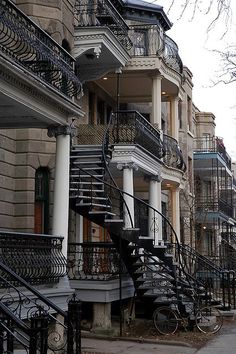Friday 21st October: Headed off to St. Helen’s Island which is on the Saint Lawrence River and looks across to old Montreal. It felt a bit like Montreal’s answer to Coney Island with its amusement park La Ronde and its Aquatic Complex, which in 1953 became Montréal’s first municipal outdoor swimming pool complex. Though on the day I went it was cold and wet so very empty. I was hoping to cross by ferry but no boats were running so I had to take the metro.
The island was named in 1611 by Samuel de Champlain in honour of his wife, Hélène de Champlain. In 1818 it was purchased by the British government and a fort, powder house and blockhouse were built on the island as defenses for the city. These are the buildings that the Stewart Museum is now housed in.
The Island has an interesting history, the newly formed Canadian government acquired the island in 1870; it was converted into a public park in 1874. The public used it as a beach and swam in the river. It was used to house prisoners of war during WW2. In 1967 it was chosen as the site of Expo 67, a World’s Fair on the theme of Man and His World. Together with the man-made Notre Dame Island they form the Parc Jean-Drapeau, which has a sculpture park across the two islands. A lot of the sculptures were made for the Expo 67 including Alexander Calder’s “L’homme” or in English “Man, Three Disks”. There is currently a hot debate about moving it into the city so more people can see it.
Alexander Calder’s “L’homme”
There are other works by Jean le Fébure, Robert Roussil, Yves Trudeau, and Sebastián. A later addition is La Ville imaginaire by João Charters de Almeida, made in 1997. This sculpture is made out of white granite from Portugal. A gift from the Metropolitano de Lisboa to the Société de transport de Montréal (Montreal Transport Company) this work commemorates the 30th anniversary of Montreal’s Metro subway system and Expo 67. ‘The sculpture is a reflection on how humans create mythical spaces, both out of necessity and in response to challenges’. It made me think of Catherine’s Stonehenge prints.
La Ville imaginaire by João Charters de Almeida
Researching the Expo 67 I found that the amazing building I photographed while down at Vieux-Port was Habitat, designed by Moshe Safdie for the Expo. Also the architect of the geodesic dome on St. Helen’s was Buckminster Fuller. It was the American Pavilion for 1967. It is now the Biosphere museum dedicated to ecology and the environment. I should have guessed the moment I saw the structure that it was Buckminster Fuller.
Habitat, designed by Moshe Safdie
Biosphere geodesic dome by Buckminster Fuller.
I was hoping to meet the Stewart Museum Head of Collections, Sylvie Dauphin. Sadly this wasn’t possible. I wanted to ask her several questions about the Cabinet de curiosités exhibition curated by the artist Jerome Fortin. The concept of making cabinets of curiosities using museums objects is central to a lot of my working practice. It was therefore disappointing and frustrating to see such a great opportunity presented in a rather heavy-handed and ‘ikea’ fashion. There was a corridor of primary/secondary colour doors with large numbers that you either opened or peer through to reveal an arrangement of museum objects. There should have been a sense of discovery and wonderment rather than just being a bit mundane.
Cabinet de curiosités exhibition curated by the artist Jerome Fortin
The high light was the room with colanders back lite, which reminded me of Catherine’s work ‘Moons’.
The permanent exhibit, History and Memory had some beautiful objects. Outside there was an impressive row of canons in different states of decay.
I was hoping that the Stewart Museum might be a suitable place for Cicatrix but the focus of the museum was very much on Quebec history. I have visited other places that I think will be more appropriate.
Images old and new of St.Helen’s Island
We returned back to Montreal and intended to walk around the old town but instead ended up at a rally for the homeless downtown in Phillips Square. We were drawn to it by a projection onto the church façade. Susan Francis, one of the original cicatrix artists, is working on a major project called The Word on the Streets (Do I know you?) https://doiknowyoublog.wordpress.com/, which is about homelessness.
Then it was off to a pub to see an all female post-punk band who were wonderfully visual and full of energy.
Tomorrow is my last day and I intend to spend it gathering images of Montreal. Also firming up plans with Catherine.




























































































